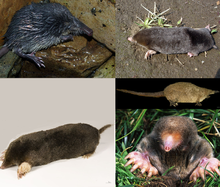List of talpids
Talpidae is one of the four families of small mammals in the order Eulipotyphla.
A member of this family is called a talpid and the family includes moles, shrew moles, and desmans.
Talpids are found in North America, Europe, and Asia, primarily in forests, shrublands, grasslands, and wetlands, though some species can also be found in deserts or coastal areas.
Talpids primarily eat earthworms, insects, and other invertebrates, but some also consume fish, mollusks, amphibians, crustaceans, plants, and fungi.
No talpids have population estimates, but the Pyrenean desman and Echigo mole are categorized as endangered species, while the Russian desman is categorized as critically endangered.
The forty-five extant species of Talpidae are divided into three subfamilies: Scalopinae, containing seven mole species in five genera, Talpinae, containing thirty-three mole, shrew mole, and desman species in eleven genera, and Uropsilinae, containing four shrew mole species in a single genus.
A few extinct prehistoric Talpidae species have been discovered, though due to ongoing research and discoveries the exact number and categorization is not fixed.
[1] Conservation status codes listed follow the International Union for Conservation of Nature (IUCN) Red List of Threatened Species.
Ranges are based on the IUCN Red List for that species unless otherwise noted.
The family Talpidae consists of three subfamilies: Scalopinae, containing seven mole species in five genera, Talpinae, containing thirty-three mole, shrew mole, and desman species in eleven genera, and Uropsilinae, containing four shrew mole species in a single genus.
Family Talpidae Scapanulus Parascalops Scalopus Scapanus Condylura Desmana Galemys Scaptonyx Urotrichus Dymecodon Neurotrichus Talpa Euroscaptor Mogera Parascaptor Neurotrichus Uropsilus The following classification is based on the taxonomy described by the reference work Mammal Species of the World (2005), with augmentation by generally accepted proposals made since using molecular phylogenetic analysis, as supported by both the IUCN and the American Society of Mammalogists.
